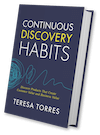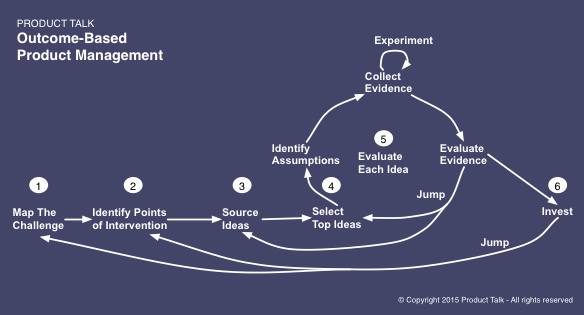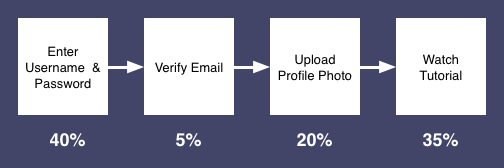 Have you heard? My new book Continuous Discovery Habits is now available. Get the product trio's guide to a structured and sustainable approach to continuous discovery.
Have you heard? My new book Continuous Discovery Habits is now available. Get the product trio's guide to a structured and sustainable approach to continuous discovery. I spend most of my time helping product teams make better product decisions.
I’m starting to notice some patterns.
I see three critical areas where we often fall short.
First, we don’t always start from a holistic or systems view of the problem we are trying to solve.
Second, we consider too few ideas.
And third, we assume our ideas will work instead of testing our assumptions before we overcommit.
A Methodology for Outcome-Based Product Management
These challenges stem from the fact that product managers manage throughput.
They fill the backlog. They keep engineers busy. They design for output.
I encourage product managers to ditch this model.
A product manager’s job isn’t to keep engineers busy. It’s not about output.
A product manager’s job is to identify, refine, and execute on the most compelling ideas that drive outcomes. – Tweet This
We are problem solvers. Not backlog managers.
What’s missing is a methodology for how to consistently drive outcomes.
The Lean Startup is helping us to shift to an experimental mindset. Agile is helping us become more iterative.
While both are great tools in our toolbox, neither provides a systematic end-to-end process that we can rely on to guide our product decisions.
This is the end-to-end process I use in my coaching practice.
It helps product managers facing big, complex, open-ended challenges make sense of their job. It gives them a place to start and a process to follow that helps them to generate innovative solutions.
1. Map the Challenge
You can’t tackle a challenge without first understanding the nature of the challenge.
This is the heart of product management.
A good product manager creates a visual map of the whole system she is working with. – Tweet This
There are many ways to do this. It might be:
- A user or customer journey
- A flow diagram of a sales process
- A system architecture layout
- A traffic flow diagram
This is the step that gets skipped most often. We think we can hold it all in our head. We get caught up by our lack of visual skills.
However, putting pencil to paper (or marker to whiteboard) helps us clarify our thinking. It helps us see the whole problem space. It helps us put ideas into context.
The goal of the visual is to communicate the nature of the challenge and to help identify points of intervention.
2. Identify Points Of Intervention
The most important decision a product manager makes is where to invest resources.
The value of the visual map is to help you identify the points of intervention that will have the biggest impact on the whole system.
Start with data on how each of the components of the system are performing.
For a customer journey, what percentage of customers are making it through each step?
For a system architecture, what are the error rates for each service?
For a sales process, where do prospects lose interest?
For a traffic flow diagram, where are bounce rates high?
This visual overview labeled with performance metrics helps you identify where you can have the biggest impact.
For example, if our sign up flow looks like this:
We might want to focus our current point of intervention on email verification.
A good product manager asks: At what point can I most positively impact the whole system? – Tweet This
3. Source Ideas
Most companies have too many ideas.
And yet they consider too few ideas when deciding what to do.
How can both of these statements be true?
The reason is that most companies don’t constrain idea generation. They entertain any and all ideas at all times.
But when they have a specific problem to solve they only consider the first feasible idea.
Avoid this trap.
A good product manager sources ideas to address a specific challenge. – Tweet This
She asks: How might we most impact this specific point of intervention?
She doesn’t just rely on her own creative thinking. She engages the whole organization in addressing this challenge.
4. Select the Top Ideas
After sourcing ideas, the product manager should identify the ideas worth pursuing.
Too many product managers rely on complex spreadsheets with half a dozen criteria to rank ideas.
This might be needed if you are considering any and all ideas.
But a good product manager only considers ideas that attack her current point of intervention.
She engages the team to rank ideas based on the expected impact of each idea on that challenge alone.
She helps the team identify the two to three ideas most worth pursuing.
5. Evaluate Each Idea
Most product teams assume their top ideas are good. They proceed as if their ideas will work.
But we know most ideas won’t work. We will be wrong more often than not.
A good product manager introduces doubt into the process. – Tweet This
She takes her top ideas and systematically explores what needs to be true in order for each idea to work.
She uncovers hidden assumptions.
She collects evidence to support or refute those assumptions.
She runs experiments as needed to collect further evidence.
She doesn’t get bogged down in experimenting for the sake of experimenting or building to learn.
Instead, she systematically explores each assumption asking: What can I learn today?
6. Invest or Jump
And finally, based on an objective evaluation of the evidence, she decides to continue to invest in the idea or she jumps.
A jump might be back to another idea on her list.
It might be back to the drawing board to source new ideas.
If she invests in an idea, she must continuously evaluate how her team’s work is impacting their current point of intervention.
Each change influences the system. The team may improve the point of intervention such that a new point in the system becomes more important.
A good product manager constantly monitors where in the system she can have the most impact. – Tweet This
She is also on the lookout for changes in the system itself. Has the market shifted? Have needs changed?
She is always refining her understanding of the challenge, shifting her points of intervention, and evaluating the ideas most worth pursuing.
It’s often hard to talk about what it is that product managers do. I hope a process like this becomes part of that answer.
Want to Learn More?
I’ve been using this process with my coaching clients for the past two years.
I’ve iterated on each step over and over again.
I’ll be writing in much more detail about this process in the coming weeks.
I’m also planning to offer a series of online courses that will allow product managers to hone their skills in each of these areas.
Don’t miss out. Subscribe to the Product Talk mailing list to make sure you don’t miss any of the upcoming articles and hear when the courses launch.


Teresa, great article! Thank you for writing. I see many bad or incomplete decisions being made by Product Managers and Product Owners. This is a great reminder of what not to do and what tools and techniques to use to validate assumptions. I keep reminding the Product Teams I coach, “Assumptions are our enemies.” 😉
Thanks, Manjit! Assumptions are only are enemies if they go untested. 🙂